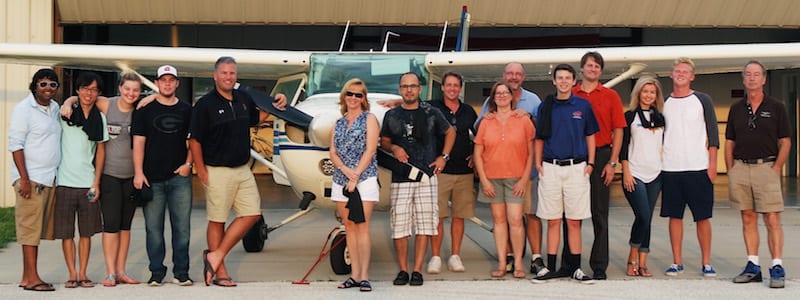Living beings have a strong tendency to travel in packs, schools, prides, pods, or convocations. Whether they find a home in the sea, on the land, or in the air, living in a congregation is the norm more often than not.
Even early humans lived and travelled in tribes for very good reason.
This propensity for group living is neither random nor unimportant. It is a behavior aviation enthusiasts would do well to adopt more intentionally. After all, we have the same basic goals as a dolphin, a gazelle, or a duck. Safety, longevity, and diversity — that’s what we’re all after.
Safety
Just as a stray calf can be nudged back into the herd for its own protection, low-time or less proficient pilots and mechanics can benefit from the wisdom and experience of older, more experienced members of the group.
Everything we do in the air requires a series of decisions. Weather, TFRs, Restricted Areas, piloting a new or unfamiliar aircraft, or even flying a familiar aircraft over unfamiliar terrain — all these variables require us to make decisions. Some we’re well suited to make. Others, not so much.
By banding together in a flying club, a pilots association, or some other organized structure that connects us with our fellow aeronauts, we can easily and comfortably obtain a second or third opinion on the conditions or the situation that is giving us pause.
And let’s face it, there are times when the situation gives us a good reason to revise or cancel our plans. Having someone there to help validate that less than joyful decision can go a long way toward establishing a safer, more life-affirming pattern of behavior.

When measured as a percentage of the population, not many young pilots go out of their way to seek out safety meetings or continuing education seminars. This is largely because they are thinking and acting as individuals. However, when involved in group-life, they are far more likely to not only attend, but to participate. That increases the safety factor for all of us.
Longevity
Each of us has our time in the sun, then we move on, making way for the next generation to take our place. Ideally, they will outpace our best efforts, putting the species in an ever stronger position, generation after generation.
That’s as true for fliers as it is for families. As a solo operator, we can have a great deal of fun in the air, but we do little to advance the science or the art of flight amongst our fellow humans.
Mentoring doesn’t have to be a Herculean task. In fact, it can be astoundingly easy to do when pursued in a socially comfortable setting. That’s true for both the mentor and the mentee.
At each gathering of the clan there are opportunities for lessons to be passed from one generation to the next. These teachings may be as simple as instilling the practice of wiping down the aircraft after flight, or teaching new arrivals that blasting the hangar is uncool and always will be.
Or it may be as complex as providing career advice, or specific insight into how to fly a particular approach or maneuver in an aircraft the newer pilot isn’t comfortable with — yet.

Peer pressure works in both directions, positive and negative. Left to their own devices, young people will often clump together, informing each other’s decision making by reinforcing it with the dubious decision making skills of their young, inexperienced peers.
On the other hand, when allowed — or better yet — encouraged to mix with older, more experienced individuals who are motivated by things somewhat more sophisticated than the average teenager is familiar with, it is possible to shift peer pressure in a more positive direction. The key is the participants have to legitimately see themselves as peers. Clubs and associations are perfectly suited to accomplish that exact thing.
Whenever we put ourselves in the position to share our wisdom, insight, and experience with someone who hasn’t had the time or opportunity to develop as we have, we improve the longevity of the group as a whole. The more relaxed, comfortable, and repeatable those opportunities are, the more powerful they become.
Diversity
While presenting a seminar on flying clubs recently, a member of my own flying club stood to address the audience. It seems he drives nearly two hours each way to attend our weekly club meetings. I had no idea. He loves the club, but he’s understandably less enthusiastic about the drive. So he asked if anyone was interested in perhaps forming a separate club nearer to his home field.
Three people raised their hands. That’s enough to make a start of it. Good for them.

The club we belong to will hate to lose this particular member, but then, we won’t really be losing him. We will instead be encouraging him to branch out, become even more involved in a club he’s got a hand in forming from the get-go. With any luck at all, we’ll establish a link between these two clubs that allow us to visit each other, hold social events together, and have an even broader effect on the aviation enthusiasts we encounter in our travels.
Just as the genetic diversity of a species can be strengthened through interbreeding, flying clubs and pilot associations can benefit from the movement of members from one group to another. When a member of a successful club accepts a job transfer, moves to a new town, joins or forms a club there, and brings the lessons of their previous club’s methods of achieving success with them, everyone benefits.

As the great and powerful Vince Lombardi so eloquently said, “Individual commitment to a group effort; that is what makes a team work, a company work, a society work, a civilization work.”
Listen to Vince. He was pretty good at making groups work, and audiences grow.
